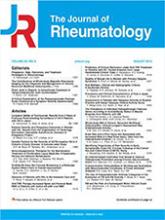
Authors: Frederico A.G. Pinheiro, Deborah C.C. Souza and Emilia I. Sato
Abstract
Objective: To evaluate rheumatoid arthritis (RA)–related mortality in the state of São Paulo (Brazil).
Methods: Data from all death certificates (DC) from 1996 to 2010 were analyzed using a multiple cause-of-death method. We compared the results from 2 subperiods (1996-2000 and 2006-2010).
Results: We found 3955 DC related to RA — 27.6% with RA as the underlying cause of death (UCD) and 72.4% with RA as the nonunderlying cause of death (NUCD). Ninety percent of RA-related deaths occurred at age ≥ 50 years. The mean ages at death were 67.1 ± 13.3 and 67.9 ± 13 years for RA as the UCD and NUCD, respectively. The most frequent NUCD associated with RA were pneumonia, sepsis, renal failure, interstitial lung disease, and heart failure. In the last subperiod, there was an increase in infectious causes. When RA was an NUCD, we observed a decrease in the mean age at death for the last subperiod (p = 0.021). The most common UCD were circulatory and respiratory system diseases. Comparing the mean age at death between RA-related deaths and the general population when deaths occurred at ages beyond 50 years, the linear regression analysis showed a downward curve for RA-related death (p < 0.001 and r = –0.795), while for the general population, as expected, the curve had an upward pattern (p < 0.001 and r = 0.993).
Conclusion Unexpectedly, RA-related deaths occurred at earlier ages in the more recent subperiod. Cardiovascular disease remained the most important cause, and infectious diseases are an increasing cause of death associated with RA, raising the question of whether infections were related to the more vigorous immunosuppressive treatment recommended by recent guidelines.


